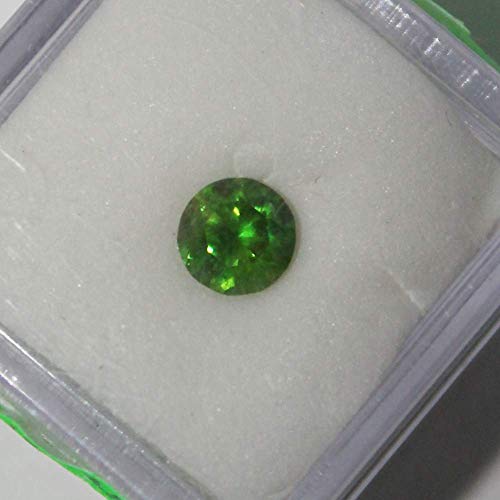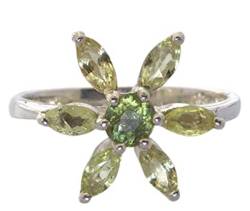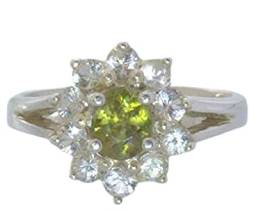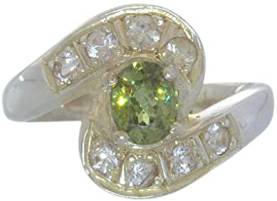Demantoid garnets are the rarest and most precious of all garnet varieties. Greener than an emerald and displaying more fire than a diamond, they are magnificent gems. Jewelry lovers and gem aficionados prize demantoids for their beauty and rarity.
We have discovered new deposits of Demantoid after 1990. Yet the gemstone remains incredibly rare. It also remains the most valuable garnet of any species. The price per carat of unblemished stones that can be faceted is very high.
Demantoid Garnet Rough, Faceted Demantoid
Click On The Image
There are, however, some demantoids with the highly coveted horsetail inclusions as blemishes. Consequently, collectors are attracted to gems with wavy, golden, and fibrous inclusions. Therefore, their value increases significantly.
Do you know what Demantoid is?
Excavators discovered Demantoid in Russia in the early 19th century. Nils Gustaf Nordenskiöld, the noted mineralogist, recognized this gem variety as an andradite garnet in 1854. The dazzling fire & brilliance of the stone inspired him to call it ‘demantoid.’
The Story Behind the Name:
The name demantoid is a blend of two words. First is the German word ‘demant,’ which means diamond. At the same time, the second word is the ancient Greek word ‘eidos’ which means alike.
The etymology refers to one of the exquisite attributes of diamonds known as ‘fire.’ A diamond shows rainbow-colored flashes (known as fire) due to the play of light within the stone. Demantoids, too, display such multi-colored flashes of light (fire). Hence the name ‘Demantoid,’ which means akin to a diamond. Even so, the green color of this gem camouflages the fire occasionally.
Click On The Images
How well does demantoid work as a jewelry stone?
Dazzling brilliance and extraordinary light dispersion are the hallmarks of a demantoid. What’s more, this mineral even surpasses diamonds in these two attributes. Likewise, it beats all other prominent green gems (like emerald and peridot) for these traits. Consequently, these stones are excellent for crafting jewelry.
It is also true that demantoids have a relatively low hardness of around 6.5 on Moh’s scale. As a result, they tend to scratch easily. Therefore, jewelers set them in protective settings to keep them safe.
The La Belle Époque (French for “Beautiful Epoch”) period between 1880 to 1914 saw the rising popularity and demand for Demantoid. The gem also found favor with ruling Russian Czars of the time.
Demantoids came exclusively from Russia for a long time. Expectedly, supplies started dwindling with time. Consequently, only antique jewelry pieces could display these gems. Nevertheless, we have discovered more deposits in Namibia, Madagascar, and other places since the 1990s. Also, the resurgence of mining in Russia has somewhat improved the gemstone’s availability. Yet the gems remain scarce. Due to the scarcity mentioned above, demantoids are costly jewelry stones.
The remarkable rarity of fine garnets means that collectors continue to acquire these gems before jewelers even get the opportunity to see their beauty. Only the most prestigious designers and brands have used demantoid garnets in their jewelry. Tiffany&Co, IVY New York, Hemmerle, Fabergé, and JAR are some.
Demantoid Garnet White Sapphire Handmade Silver Sweeping Ring
Click On The Image
Are Horsetail Inclusions a Feature of All Demantoids?
Chrysotile and byssolite horsetail inclusions take their name from their golden color and wavy appearance. Gemological labs and independent gemologists use them as one of the yardsticks to identify natural demantoids. However, non-demantoid (brown) andradite also shows these inclusions. So this single attribute is deemed inadequate in determining natural demantoids.
Inclusions may form a cat’s eye gem in demantoids on infrequent occasions.
Differentiating Between a Demantoid and an Emerald?
Despite having similar color & appearance, demantoids and emeralds have distinct optical and physical properties. Demantoids exhibit almost no birefringence and more excellent dispersion than Emeralds.
Best Color
Demantoid garnets are perceived best in daylight, just like diamonds. Their color appears yellowish-green under incandescent light. Most people prefer the vivid green emerald-like color devoid of any yellow tint.
What About Synthetic Demantoids?
We have not been able to create synthetic Demantoid in the lab yet. Even so, unscrupulous elements do not hesitate to use green color glass and green yttrium aluminum garnet (YAG) (another synthetic garnet) as Demantoid simulants.
Are There Any Enhancement Techniques For Demantoid Garnets?
Heat treatment may enhance demantoid color. However, it is a stable process that is not easily detectable.
The size of Stones:
Demantoids tend to occur in small sizes. For example, we do not see stones of more than 10 carats very often. Similarly, faceted stones are usually under 0.50 carats.
The Russian Ural mountain range has yielded the largest Demantoid discovered so far. The stone tipped the scale at 252.5 carats.
A Christie’s auction held in Hong Kong in 2008 sold a ring featuring a 5.5-carat Russian demantoid garnet for a staggering $170,876. The ring exceeded the highest pre-sale estimate by $50,000.
Geographical Gem Deposits
A mid-19th-century discovery of demantoid garnets in the Russian Urals kindled the interest of the ruling czars. Prospectors mined the stone in this region till the First World War.
Carl Fabergé, the Russian jeweler (of the Fabergé eggs fame), could not resist the beauty of this gem. He created numerous artworks and jewelry pieces using the jewel. The czars and upper echelon nobility patronized his works. Unfortunately, the ensuing Soviet era all but forgot these mines.
Come 1996, and prospectors discovered demantoid garnets in Namibia. They are still excavating demantoids from ‘The Green Dragon,’ mine that extends over more than 100,000 hectares.
Comparing Namibian and Russian Demantoid Garnets:
Russian demantoids are among the most valuable garnets, as they differ in color and inclusions from Namibian garnets. The most noticeable distinction is the color spectrum.
Namibian garnets typically come in greens, blueish-greens, olive-greens, and yellowish-browns. On the other hand, Russia’s Ural Mountains host Demantoids that exhibit a vivid emerald green color. And this is their most treasured attribute.
The presence of the bissolite horsetail inclusions also helps identify Russian Ural Demantoids. These are fine thread-like inclusions resembling the tail of a horse. This particular inclusion is another sought-after feature of demantoids from the Ural region.
Demantoids: Care Instructions
Warm water, detergent, and a soft brush are the best ways to clean heat-sensitive garnets, such as demantoids. Don’t use mechanical cleaning and also protect the gem from extreme heat.
See More Gemstones As Follows



